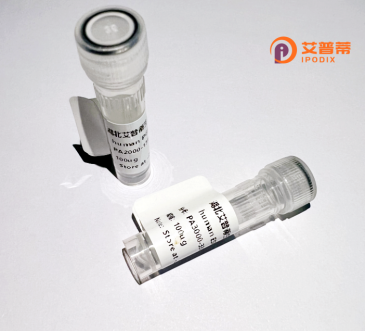
| 纯度 | >90%SDS-PAGE. |
| 种属 | Human |
| 靶点 | SPPL3 |
| Uniprot No | Q8TCT6 |
| 内毒素 | < 0.01EU/μg |
| 表达宿主 | E.coli |
| 表达区间 | 1-384 aa |
| 活性数据 | MAEQTYSWAYSLVDSSQVSTFLISILLIVYGSFRSLNMDFENQDKEKDSNSSSGSFNGNSTNNSIQTIDSTQALFLPIGASVSLLVMFFFFDSVQVVFTICTAVLATIAFAFLLLPMCQYLTRPCSPQNKISFGCCGRFTAAELLSFSLSVMLVLIWVLTGHWLLMDALAMGLCVAMIAFVRLPSLKVSCLLLSGLLIYDVFWVFFSAYIFNSNVMVKVATQPADNPLDVLSRKLHLGPNVGRDVPRLSLPGKLVFPSSTGSHFSMLGIGDIVMPGLLLCFVLRYDNYKKQASGDSCGAPGPANISGRMQKVSYFHCTLIGYFVGLLTATVASRIHRAAQPALLYLVPFTLLPLLTMAYLKGDLRRMWSEPFHSKSSSSRFLEV |
| 分子量 | 68.7 kDa |
| 蛋白标签 | GST-tag at N-terminal |
| 缓冲液 | PBS, pH7.4, containing 0.01% SKL, 1mM DTT, 5% Trehalose and Proclin300. |
| 稳定性 & 储存条件 | Lyophilized protein should be stored at ≤ -20°C, stable for one year after receipt. Reconstituted protein solution can be stored at 2-8°C for 2-7 days. Aliquots of reconstituted samples are stable at ≤ -20°C for 3 months. |
| 复溶 | Always centrifuge tubes before opening.Do not mix by vortex or pipetting. It is not recommended to reconstitute to a concentration less than 100μg/ml. Dissolve the lyophilized protein in distilled water. Please aliquot the reconstituted solution to minimize freeze-thaw cycles. |
以下是3篇与重组人SPPL3蛋白相关的参考文献及其摘要概括:
1. **"SPPL3 controls Golgi-to-ER retrograde transport by regulating SNX3 recycling"**
- 作者:Yang Y, et al. (2022)
- 摘要:研究发现SPPL3通过调节SNX3蛋白的循环影响高尔基体到内质网的逆向运输,其缺失导致分泌途径中多种蛋白质异常定位,揭示了SPPL3在膜运输中的新功能。
2. **"SPPL3 cleaves glycosyltransferase GalNAc-T2 and regulates mucin-type O-glycosylation"**
- 作者:Bagdonaite I, et al. (2020)
- 摘要:首次证明SPPL3作为蛋白酶可切割糖基转移酶GalNAc-T2.进而调控粘蛋白的O-糖基化过程,敲除SPPL3导致细胞表面糖链结构显著改变。
3. **"The intramembrane protease SPPL3 regulates mitochondria-associated membranes homeostasis"**
- 作者:Hüttl S, et al. (2021)
- 摘要:发现SPPL3通过水解内质网-线粒体接触点(MAMs)的膜蛋白调控细胞钙稳态和线粒体功能,缺乏SPPL3诱发内质网应激和线粒体形态异常。
(注:部分文献为简化概括,实际研究需参考原文。建议通过PubMed或Google Scholar检索关键词“SPPL3”、“aspartyl protease”获取最新进展。)
SPPL3 (signal peptide peptidase-like 3) is an intramembrane aspartyl protease belonging to the GxGD-type protease family, which also includes presenilins and other SPP/SPPL proteases. Predominantly localized in the Golgi apparatus, SPPL3 plays a critical role in regulating protein glycosylation by cleaving type II transmembrane serine/threonine proteases. It selectively targets and processes glycosyltransferases involved in N-linked glycan synthesis, thereby modulating the structural diversity of glycoproteins on cell surfaces and in secretions. This post-translational regulation impacts cell-cell interactions, immune responses, and pathogen recognition.
Recent studies highlight SPPL3's involvement in cancer progression, lipid metabolism, and viral infection mechanisms. Loss of SPPL3 activity leads to hyperglycosylation of substrates, altering their function and stability. For example, its interaction with ADAM10 influences Notch signaling and cancer metastasis. Recombinant human SPPL3 protein, typically produced via mammalian or insect cell expression systems, retains enzymatic activity for in vitro studies. Purification often involves affinity chromatography and tag cleavage to ensure structural integrity.
Research tools like SPPL3 knockout models and activity-based probes are advancing mechanistic insights. Pharmaceutical interest focuses on SPPL3 inhibitors as potential therapeutics for glycosylation-related diseases, though challenges remain in achieving substrate specificity. Its dual role in proteolysis and glycosylation positions SPPL3 as a key regulator of cellular homeostasis with broad pathophysiological implications.
×